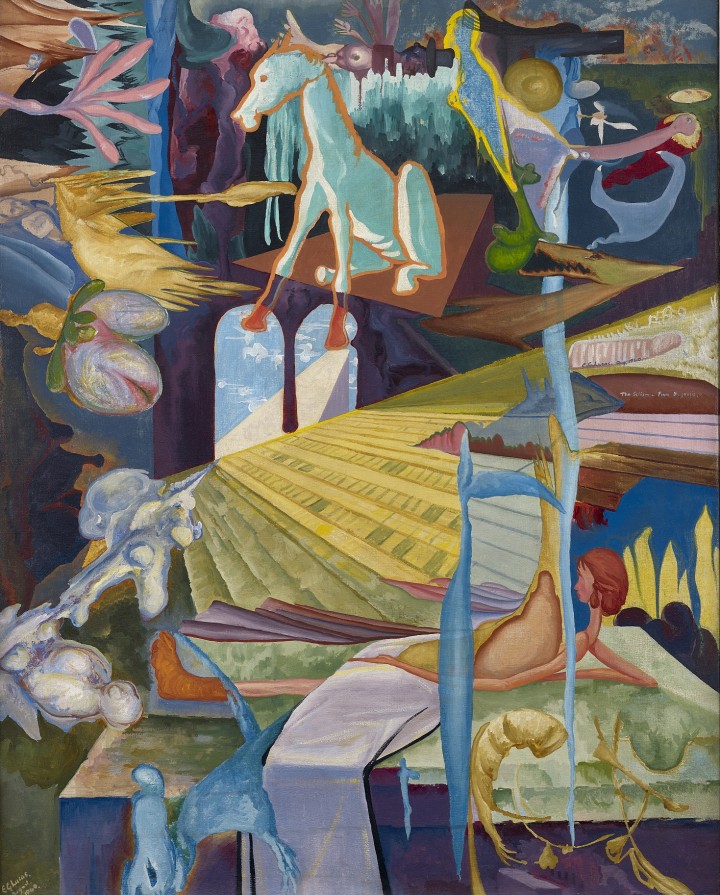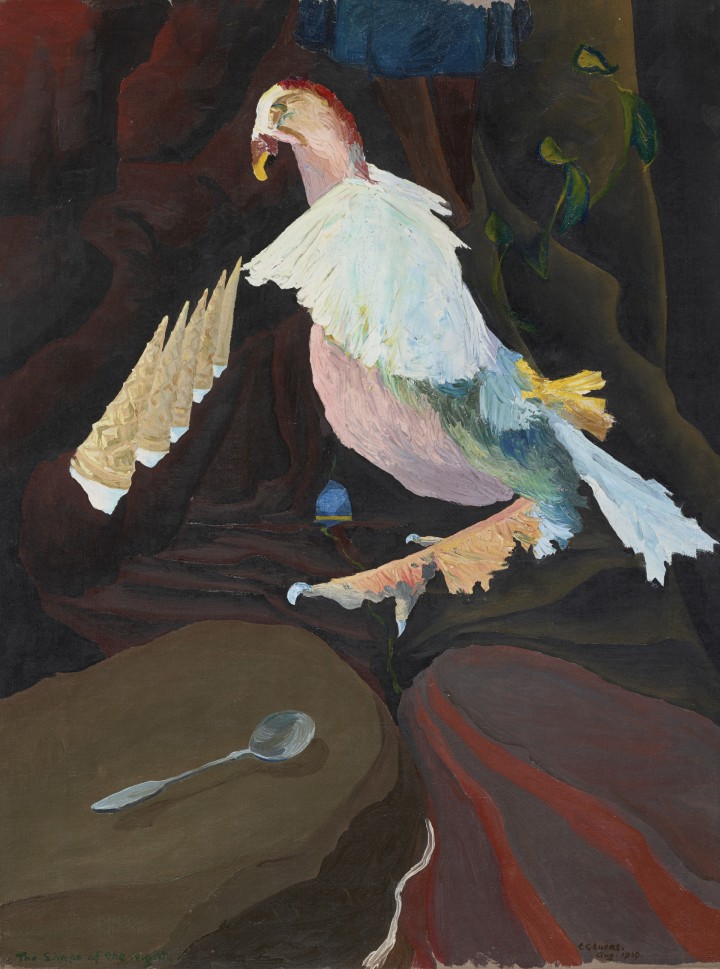Scottish Art News
Latest news
Magazine
News & Press
Publications
The Surreal Case of Edwin Lucas
By Patrick Elliott, 01.05.2016

I remember an American museum director telling me, years ago, that a visitor had called from the front desk of his museum, asking to show him a picture. The director thought twice about it, but decided to go and see. It turned out to be a seventeenth-century painting, and the man had a Rubens at home. The museum was given both. So when someone writes or calls saying they have a picture, I do my best to see it. It is part of the job, but I have that Rubens in mind.
In 2011, someone wrote in, stating that they had seen ‘Another World’, a big exhibition on Surrealism that I had organised at the Scottish National Gallery of Modern Art. He explained that his father, Edwin Lucas (1911–90), was a Scottish Surrealist artist and asked whether I would be interested in seeing his pictures. I had not heard of Lucas, but I checked on the incomparable BBC ‘Your Art’ website and found a really odd, arresting painting in the City Art Centre; it reminded me of the old Ready Brek television advert in which a boy walks to school, imprisoned by a sort of nuclear glow. I do like odd artists, who do not fit into categories, so I said, yes, I would have a look.
.jpg) Edwin G. Lucas, Organic Abstract, 1986. Lucas Family Collection. © the artist's estate. (Photo: John McKenzie)
Edwin G. Lucas, Organic Abstract, 1986. Lucas Family Collection. © the artist's estate. (Photo: John McKenzie)
I cycled out to a modern bungalow on the fringes of Edinburgh and have to confess that I did not have high hopes. Ceramic ducks flying in formation or a reproduction of Vladimir Tretchikoff’s Chinese Girl seemed more likely finds. A friendly couple greeted me and offered me coffee. Inside, the walls were filled with some of the weirdest paintings I had ever seen, dating mainly from the 1940s, crazy pictures in all sorts of styles. They made me think of Francis Picabia (1879–1953), doyen of Dadaism and Surrealism, and one of the most left-field artists of the twentieth century; George Condo (b.1957), an American artist who is all the rage and sells for big money; and some of the so-called ‘Bad Painters’ of recent years – Stella Vine and Martin Maloney, artists Saatchi bought. Only these pictures by Lucas were, in my mind, more compelling and unfathomable, partly because there was (or seemed to be) no irony or intention to shock.
My mouth still agape, and holding on to my coffee, I listened to my host, Lucas’s son. His father, Edwin George Lucas was born in Leith, the port of Edinburgh, in 1911. He showed a talent for drawing and painting at an early age, but his family discouraged him from considering art as a career. It transpired that Lucas’s uncle, E. G. Handel Lucas, had been a good Victorian painter but had struggled to make ends meet and so the family was quick to snuff out interest in art among the younger generation. Lucas attended evening life-drawing classes at Edinburgh College of Art for a number of years, but was otherwise entirely self-taught. He worked for the Civil Service in Edinburgh and took a law degree at the University of Edinburgh.
 Edwin Lucas, The Shape of the Night, 1939. National Galleries of Scotland. Presented by Alan and Frank Lucas, in memory of their father, Edwin Lucas, 2013. © www.edwinglucas.com
Edwin Lucas, The Shape of the Night, 1939. National Galleries of Scotland. Presented by Alan and Frank Lucas, in memory of their father, Edwin Lucas, 2013. © www.edwinglucas.com
Throughout the 1930s, Lucas worked mainly in watercolours but towards the end of the decade he turned seriously to oil paint, and at the same time ‘flirted’ (the term he used) with Surrealism. A big show of Surrealist art held at the New Burlington Galleries in London in 1936 sparked interest in Surrealism around the UK (famously, Salvador Dalí attended the opening, and nearly suffocated in a full diving suit). A few Surrealist paintings by Giorgio de Chirico (1888–1978), Dalí (1904–89) and Max Ernst (1891–1976) were shown in the annual exhibition of the Society of Scottish Artists held in Edinburgh in December 1937, the year that Lucas also exhibited, although his must have been a more traditional work. Other Surrealist paintings, including a work by Yves Tanguy (1900–55), were shown at the University of Edinburgh in May 1939. In June 1939, the New Era Group, which included William Gear (1915–97) among its number, held a Surrealist exhibition at Gladstone’s Land Galleries in Edinburgh. Gear was a close friend of artist Wilhelmina Barns-Graham (1912–2004), who sublet her studio to Lucas, and it seems likely that Lucas attended this exhibition.
So, there were opportunities for Lucas to see Surrealist paintings first-hand. He produced a small body of Surrealist works between 1939 and 1941 and surreal elements were an important part of his work thereafter, even though he stopped regarding himself as a Surrealist painter. In terms of Scottish art, his interest in Surrealism marked him out as unusual. A small number of others experimented with the surreal, but only briefly: Edward Baird (1904–49), James Cowie (1886–1956), Charles Pulsford (1912–89), William Johnstone (1897–1981), and a couple of others. That so few Scottish artists became interested in Surrealism was partly due to the nature of the Scottish art market, which was conservative, and there were hardly any buyers for that type of work. In this respect, Lucas was in an advantageous position: he had an income and did not need to sell.
 Edwin G. Lucas, Water of Leith Valley and Pentland Hills from Kingsknowe, 1938. City Art Centre, Museums & Galleries Edinburgh. © the artist's estate. (Photo: Antonia Reeve)
Edwin G. Lucas, Water of Leith Valley and Pentland Hills from Kingsknowe, 1938. City Art Centre, Museums & Galleries Edinburgh. © the artist's estate. (Photo: Antonia Reeve)
Lucas’ son and I looked at one painting, which was on a loose piece of canvas and called The Shape of the Night. Dating from 1939, it showed a bird of prey, a spoon and some triangular motifs hovering in the air; these turned out to be ice- cream cones. The title is pure René Magritte, but the painting had something very individual about it. Also individual were the crystals growing on the surface – it had evidently been kept in a damp environment. We later went to a lock-up on the way out to Edinburgh airport and looked at a further fifty or so works. About a year later, The National Galleries of Scotland purchased, at very modest prices, four paintings from the 1940s, and The Shape of the Night came as a gift from the family, in memory of their father. It cleaned up a treat and now hangs between Dalí and Magritte paintings worth millions.
Lucas submitted some of his Surrealist pictures to exhibitions at the Royal Scottish Academy in the 1940s, but they were usually rejected; his more traditional landscapes were hung instead. He held two one-man shows at the New Gallery in Shandwick Place, Edinburgh, in 1950 and 1951, and included all his Surrealist work, but the shows received little attention from the art establishment. Following his marriage in 1952, he stopped painting and only picked up his brushes again in the early 1980s. He died of leukaemia in 1990, his work virtually unknown.
I am still bowled over by the pictures. If you have a fair grounding in the history of art, you can usually figure out where an artist got this or that motif or style from, but with Lucas I have no idea why he painted these works, or what they mean, or how on earth he adopted that style when nobody else was painting in that way at that time. Which is why it is always a joy to look at them.
Patrick Elliott is Curator at the National Galleries of Scotland. Edwin Lucas's work was shown as part of Surreal Encounters | Collecting the Marvellous at the Scottish National Gallery of Modern Art in 2016. In 2018 Edinburgh's City Art Centre exhibited a solo show of Lucas's work. More can be discovered about his work at edwinglucas.com.




